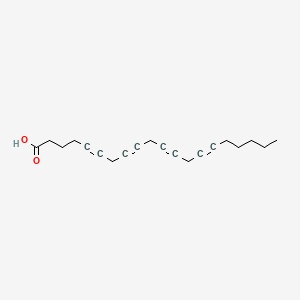|
|
|
|
pmid:12957656
|
| el-Etr M et al. |
A monoclonal anti-idiotypic 'internal image' antibody that recognizes the A1 adenosine receptor potentiates the alpha 1-adrenergic activation of phospholipase C in primary cultures of mouse striatal astrocytes. |
1992 |
Neurosci. Lett. |
pmid:1334241
|
| Mack SR et al. |
The human sperm acrosome reaction does not depend on arachidonic acid metabolism via the cyclooxygenase and lipoxygenase pathways. |
1992 Nov-Dec |
J. Androl. |
pmid:1338069
|
| Delumeau JC et al. |
Synergistic regulation of cytosolic Ca2+ concentration by somatostatin and alpha 1-adrenergic agonists in mouse astrocytes. |
1992 |
J. Physiol. Paris |
pmid:1364195
|
| Pivovarov AS et al. |
[Lipoxygenase inhibitors, eicosapolynoic acids, attenuate the short-term plasticity of the cholinoreceptors of snail neurons]. |
1991 Nov-Dec |
Zh Vyssh Nerv Deiat Im I P Pavlova |
pmid:1369571
|
| Johansson M et al. |
Production of HETEs in human neutrophils; dependence of arachidonic acid. |
1992 |
Biochem. Soc. Trans. |
pmid:1397529
|
| Chen N et al. |
Inhibition by arachidonic acid and other fatty acids of dopamine uptake at the human dopamine transporter. |
2003 |
Eur. J. Pharmacol. |
pmid:14575792
|
| Yoshida M and Koeda T |
Studies on the electrical stimulation-induced contractile responses of hamster and mouse gallbladders. |
1992 |
J Smooth Muscle Res |
pmid:1457959
|
| Bryja V et al. |
Lipoxygenase inhibitors enhance tumor suppressive effects of jun proteins on v-myb-transformed monoblasts BM2. |
2003 |
Prostaglandins Other Lipid Mediat. |
pmid:14674625
|
| Bandell M et al. |
Noxious cold ion channel TRPA1 is activated by pungent compounds and bradykinin. |
2004 |
Neuron |
pmid:15046718
|
|
|
|
|
pmid:15104243
|
| Zuo L et al. |
Lipoxygenase-dependent superoxide release in skeletal muscle. |
2004 |
J. Appl. Physiol. |
pmid:15107407
|
| Sánchez-Ferrer CF et al. |
Endothelial modulation of the ouabain-induced contraction in human placental vessels. |
1992 |
Circ. Res. |
pmid:1516165
|
| Sokolowski BH et al. |
Identification and localization of an arachidonic acid-sensitive potassium channel in the cochlea. |
2004 |
J. Neurosci. |
pmid:15254081
|
| Liu Q et al. |
NADPH oxidase produces reactive oxygen species and maintains survival of rat astrocytes. |
2005 Mar-Apr |
Cell Biochem. Funct. |
pmid:15386527
|
| Downie MM et al. |
Peroxisome proliferator-activated receptor and farnesoid X receptor ligands differentially regulate sebaceous differentiation in human sebaceous gland organ cultures in vitro. |
2004 |
Br. J. Dermatol. |
pmid:15491415
|
| Anderson KM et al. |
ETYA, a pleotropic membrane-active arachidonic acid analogue affects multiple signal transduction pathways in cultured transformed mammalian cells. |
1992 |
Clin. Biochem. |
pmid:1551235
|
| Li F and Malik KU |
Angiotensin II-induced Akt activation through the epidermal growth factor receptor in vascular smooth muscle cells is mediated by phospholipid metabolites derived by activation of phospholipase D. |
2005 |
J. Pharmacol. Exp. Ther. |
pmid:15525798
|
|
|
|
|
pmid:15556273
|
| Rousseau E et al. |
Capsazepine, a vanilloid antagonist, abolishes tonic responses induced by 20-HETE on guinea pig airway smooth muscle. |
2005 |
Am. J. Physiol. Lung Cell Mol. Physiol. |
pmid:15557084
|
